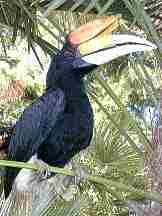The New York Times, May 11, 2004
Amid Jungle Cacophony, Hornbills Heed Monkeys' Alarms. (Science Desk) Carol Kaesuk Yoon.

|
The New York Times, May 11, 2004 Amid Jungle Cacophony, Hornbills Heed Monkeys' Alarms. (Science Desk) Carol Kaesuk Yoon.
|
 |
|
Full Text: COPYRIGHT 2004 The New York Times Company
In Ivory Coast, the jungle is theater for a boisterous symphony of sound: the penetrating buzz of cicadas; the barks, whistles and moans of monkeys; the deafening roar of leopards; and the melodies of songbirds from earth to treetop. These animal Towers of Babel are so overwhelming that it would seem a challenge for any creature to decipher its own species' calls, let alone translate the language of another. But in a study in the April 7 issue of The Proceedings of the Royal Society: Biological Sciences, scientists at the University of St. Andrews in Scotland report that in the African rain forest, large fruit-eating birds known as hornbills can decipher calls of the Diana monkey.
When these birds hear the monkeys excitedly calling out the signal for an incoming crowned eagle -- a huge predator that would eat hornbills or monkeys -- they immediately take precautions. But if they hear the monkeys shouting a warning against leopards, a hunter that doesn't bother with hornbill meat, the birds likewise don't bother about it.
''They're both a barking, coughing sound, very similar sounding,'' said Hugo Rainey, a graduate student researcher at St. Andrews and the lead author on the paper. ''When you hear them in the forest, it's not easy to distinguish them.'' Researchers say it is the first time that a bird has been shown to distinguish the calls of any monkey or any mammal, for that matter, from among the signals, sounds and general ruckus of the natural world.
''Educated eavesdropping may actually be a more common phenomenon than it now appears, only because few people have looked for it,'' said Dr. Jack Bradbury, a behavioral ecologist and director of the Macaulay Library of Natural Sounds at Cornell University, who was not involved with the study. ''I bet we shall find a number of such situations once we look more carefully.''
Scientists had known that monkeys could distinguish the calls of other species, both monkeys and birds, and that birds could respond to the calls of other bird species. But it was not clear that birds would be able to make out the communication of monkeys.
The researchers note that not all birds are likely to be as discriminating as hornbills, which can live to be 20 or older in the wild and are thought to be among the bird world's stronger intellects, as is typical of such long-lived creatures.
Scientists got the idea that hornbills might be listening to their neighbors when Dr. Klaus Zuberbuhler, another author of the paper along with Dr. Peter Slater, was trying to study the Diana monkey alarm calls.
On his recordings of the monkey calls, much of what he heard instead was the distractingly loud and frequent calls of hornbills. The bird is notably raucous-sounding. It has on its head a large, hollow structure -- making it look a bit like a toucan with a badly fitting hat -- that is thought to help amplify and resonate its calls.
To test the linguistic abilities of the birds, the researchers found hornbills in the forest and set out a speaker about 50 yards away. They played recordings of either the crowned eagle shriek (a high-pitched kee-kee sound), the roar of a leopard or the croaking alarm calls the Diana monkeys make to warn of those animals.
If researchers played the monkey's eagle alarm call or the call of an actual eagle (a bird with a six-foot-wide wingspan whose talons can easily skewer a grown man's arm), the hornbills would immediately start calling and would often move quickly toward the speaker.
''That's slightly counterintuitive,'' Mr. Rainey said. ''Normally you don't want to get too close to a predator. But these are surprise predators and the bird is telling the predator it knows the predator is there.''
It is a bold act, researchers say, but one that often deters the hunter.
Mr. Rainey said other studies had shown that if two monkey species could recognize and use each other's alarm calls, they could live together in greater numbers and use more of the forest for foraging.
''Presumably that would be the same with hornbills,'' Mr. Rainey said. ''They have extra pairs of eyes. It implies there are benefits of living in a world with other species, whose calls you could pick up.''